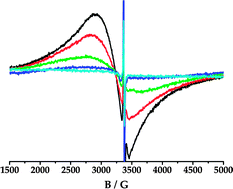Electronic, charge and magnetic interactions in three-centre systems†
Abstract
Three-centre systems [QCuQ]n containing electron transfer-active and donor-substituted o-iminoquinone ligands were synthesised and studied as models for electronic, charge and magnetic coupling within materials involving coordinative bonding. The neutral precursors (n = 0) involve spin-bearing semiquinone radical ions, Q˙−, bridged by paramagnetic copper(II). Crystal structures and electron paramagnetic resonance (EPR) measurements reveal a delicate sensitivity of structures and of spin–spin coupling in these three-centre configurations, depending on weak secondary interactions involving substituents at the coordinatively ambivalent (hemilabile) ligands Q×. Stepwise electron loss or uptake by [QCuQ]n is accompanied by considerable redox potential splitting and by spectroelectrochemically monitored change of UV-Vis-NIR absorption. Whereas the monoanions exhibit long-wavelength ligand-to-ligand intervalence charge transfer bands around 2000 nm for π(Q2−) → π*(Q˙−) transitions, the monocations are formed in a reorganisation step, achieving coordinative saturation at the metal. Weak secondary interactions are thus shown to be sufficient to cause significant structural changes as well as qualitative differences in spin–spin interaction and in excited state structures.

- This article is part of the themed collection: Interdisciplinary Symposium on Materials Chemistry 2014

 Please wait while we load your content...
Please wait while we load your content...